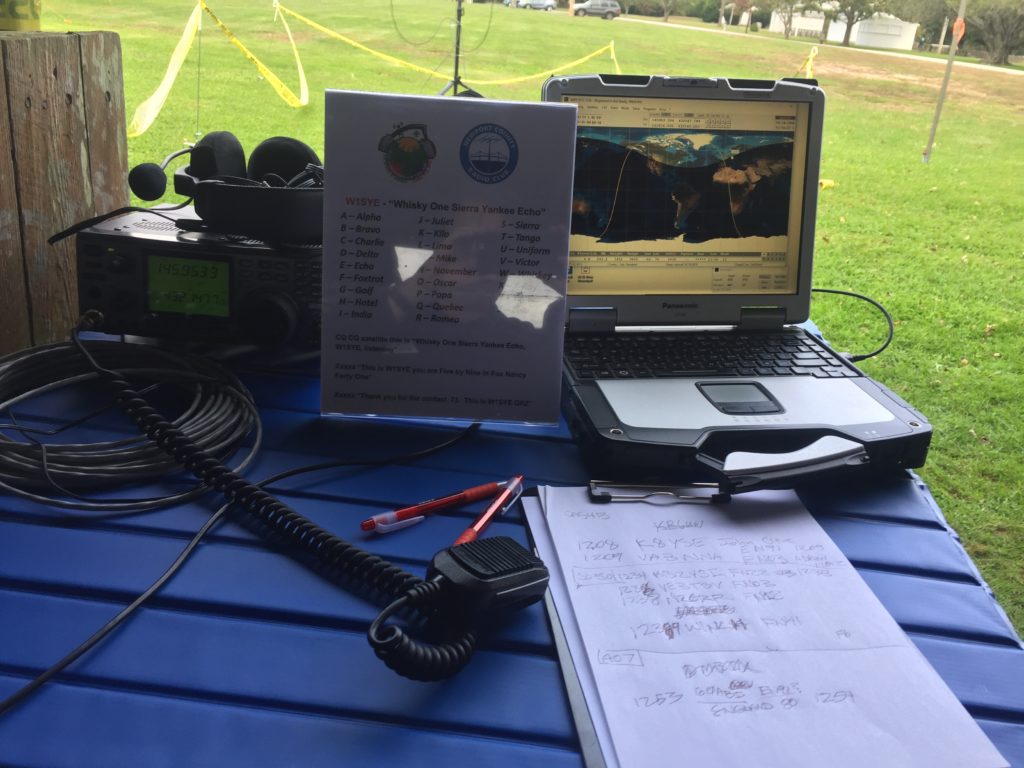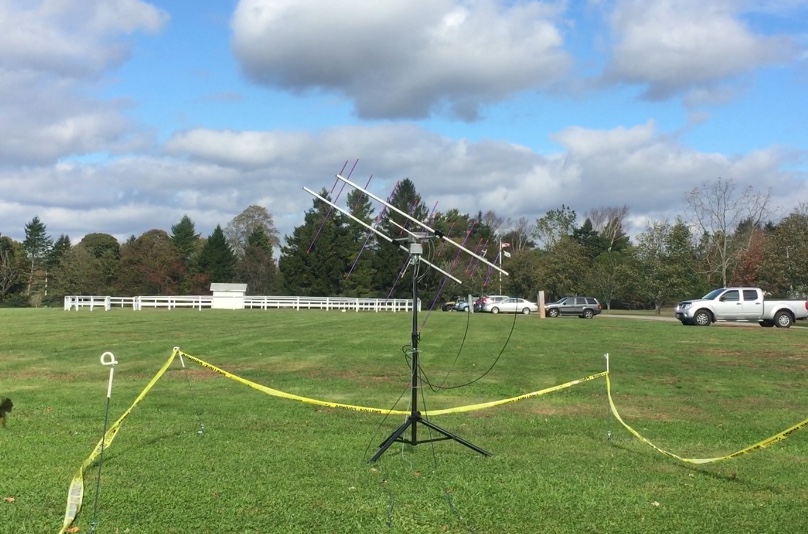Today was the sixth JOTA (Jamboree On The Air) that I’ve had the privilege of working at, along with other Newport County Radio Club members. While the weather was dicy yesterday (poor scouts trying to sleep during some rather strong wind/rain storms), when I showed up around 10:30 this morning, there was nothing left but fluffy clouds. Rob KC1ZZU and Willy W1LY, helped me to setup my satellite station shown in the photos below. By noon we were on the air and worked about 30 stations during multiple passes of AO7, SO50, AO91, AO92, and CAS4B over the next five hours. By 5 PM, with Willy & Rob’s help, the gear was stowed in my truck and I was headed home. Jim KA1ZOU and his crew worked very hard and a large number of scouts obtained their Radio Merit Badge by the time the day drew to a close.

The RF end of the station: Icom IC910H, Portable Rotation AZ/EL controller, Toughbook running SATPC32

Antenna Magic — Arrow “Alaskan” Antenna mounted on two beams for 70cm and 2m vertical, with Portable Rotation AZ/EL rotor, mounted on a Pyle speaker stand.
The equipment in use is a fairly old Icon IC-910H (2m/70cm multimode radio), and a Panasonic Toughbook removed from police service running SATPC32. The computer handles the Doppler corrections for the radio uplink and downlink, as well as tracking data for the antenna system. A PortableRotation.com AZ/EL Rotor is used to steer two halves of an Arrow Antenna “Alaskan” antenna (one Alaskan antenna plus another boom — the antennas mounted vertically on each side of the rotor’s boom). A 30 AH LiFePO4 BioennoPower battery provided the power for the radio and rotor. The system worked flawlessly for ten satellite passes over 5 hours (the LiFePO4 battery had used about 1/4 of its capacity, and the laptop battery still had another hour left in it).
The antennas worked well from horizon to horizon and provide some rather long DX into the UK, Caribbean, and South America. There were some very deep fades due to the simple vertical polarization on my end, but overall signal levels were excellent. CAS4B in particular was quite lonely. But AO7, launched 44 years ago in 1974 was VERY busy and stayed in Mode UV all day long.









Hi Bob. There are very few reviews online for the 12PRSAT Ez-El rotator. I’m interested in buying one for portable use and for Scout events. Are you still happy with the purchase and would you recommend it? Thanks!
Hi Ed,
I’ve had mine for a couple of years now and it usually works fine. I only say “usually” because the last time I used it, for some reason I have yet to figure out, it would not calibrate North correctly — it was shifted about 30 degrees off. Odd, since I had used it a few months earlier at the exact same spot and it calibrated fine. I’m unsure if I had applied a software update or not, and haven’t had time to check things out.
I would like to say that the customer service is fantastic — they really stand behind their product.
The original manual was pretty sketchy, but has been rewritten and is much better.
Amazingly light, easy to interface to SatPC32, and it beats the heck out of trying to hand-point or tripod arrow antennas. By the way, I purchased an Alaskan Arrow, and a spare beam, then mount the 2-meter elements on one boom, and the 70-cm elements on the other. helps to balance things. At some point, I am hoping they come out with phasing cables that would allow a RHCP.
73, Bob
Thank you for replying. I have been using a hand-held standard Arrow antenna and making some contacts. I tried FM birds once and then went to the linear birds. I find them easier to work since I can usually find a spot in the passband to hold a QSO. I am using an IC-9700 with MacDoppler. I like your idea of using the longer Arrows and I might order an Alaskan and an extra boom and just deal with the fades. But, I’m tempted to “go for the gold” and order the M2 LEO pack. But I’m thinking the setup/tear down time for the M2 would make portable operating a lot less fun. A friend pointed me to the ARRL Antenna Book for some ideas on making homebrew RHCP antennas. I might give that a go once I have some successes with the Alaskan setup you have. Thanks!
Can you please provide information on how you mounted the Alaskan booms to the cross booms on the rotator? I could purchase two of the Arrow antenna kits, but I’m curious if you found a different solution. Thank you.